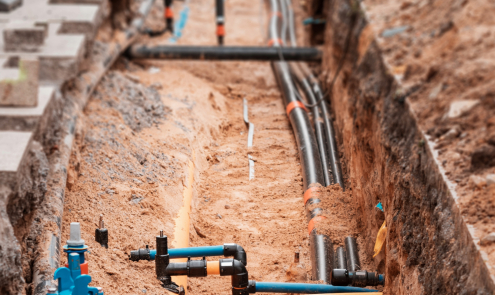APPROVED DOCUMENT R: HOW WHITECODE IS HELPING ITS CLIENTS TRANSITION TO A GIGABIT-READY INFRASTRUCTURE
22 Mar 2023
New regulatory requirements for developers to install gigabit-ready infrastructure and gigabit-capable broadband connections in new homes came into force in December 2022. These measures introduced by the government as part of the updated Building Regulations are designed to future-proof homes for faster broadband speeds. However, for developers preparing to install fibre broadband infrastructure and connections that support gigabit speeds, it can be difficult to know where to begin. Whitecode discusses how it is supporting its clients to install mandatory gigabit-capable connections as part of the construction process.
As part of the updated of the updated Building Regulations which came into effect in 2022, Approved Document R volume 2: Physical infrastructure for high-speed electronic communications networks (2022 edition) applies to the erection of new buildings other than dwellings and when existing buildings (including dwellings) are subject to major renovation works.
R1 Building work must be carried out so as to ensure that the building is equipped with a high-speed-ready in-building physical infrastructure, up to a network termination point for high-speed electronic communications networks.
In The Secretary of State’s view, a building will meet requirement R1 if it is designed and constructed so that high-speed electronic communications networks can be installed in the future. Document R stipulates that a suitable position for at least one network termination point should be identified for the erection of a new building other than a dwelling, for an existing building (including an existing individual dwelling) that is subject to major renovation works, and for each dwelling in an existing multi-dwelling building that is subject to major renovation works. Suitable ducting should be provided to connect all such network termination points to an appropriate access point or common access point.
What the specification means
Document R states ‘R1 applies to new buildings and to existing buildings that are subject to major renovation works, including existing dwellings subject to such works.' As specific gigabit speeds have not been stated the developer may be able to re-use existing infrastructure that is already in place and will not have to replace and reinstall all of it.
According to the standard ‘a standard copper telephone cable, when connected to a service provider’s fibre network, can deliver broadband speeds up to 70 Mbps,’ therefore suggesting that telecommunications systems may be suitable. Ostensibly, the focus on both of these standards is to ensure new residential buildings have gigabit-ready services and infrastructure. This may be in part due to the significant increase in working from home capability and how the government predicts that this will continue to grow in the coming years.
In support of the government’s gigabit-ready infrastructure plan, network providers have put their own ambitious plans in place. In 2021, Virgin Media completed the upgrade of its entire national network to gigabit speeds, delivering nearly two-thirds of the Government’s broadband ambition four years ahead of the target date and cementing the company’s status as the UK’s largest gigabit provider. In 2022, Hyperoptic hit its target of connecting over 100,000 new build homes to its full fibre network. It also has agreements in place to connect a further 100,000 new build properties within the following twelve months. Openreach aims to deliver Ultrafast full Fibre Broadband to 25 million homes and businesses by December 2026.
Meeting Part B requirements
The Part B requirement is to provide only the in-building physical infrastructure, from the service provider’s access point to the occupier’s network termination point. Multi-dwelling buildings that are subject to major renovation works must be equipped with a common access point capable of serving all the dwellings within the building.
Meeting Part B is of paramount importance for us as designers, as this mainly relates to the correct provision of fire-stopping which Whitecode generally has a large involvement in on new and existing buildings. Our consultants will have initial meetings with the client, developer, architect, structural engineer and fire consultant and agree a strategy for fire-stopping services within a building, we can offer up products and methods for minimising the impacts of an existing building while still meeting the requirements of Part B.
We would determine the most beneficial method of installation that would minimise the impact of the existing building while ensuring the amendment to the telecommunications networks will be installed in the most cost-effective. This would involve investigating service routes and risers and coordinating builders works with the design team.
Helping developers make the transition
As with any new changes, it can be difficult to know where to begin. At Whitecode we have a skilled team of Mechanical and Electrical Plumbing Engineers who are up to date on the latest regulations and practices and can advise on which steps to take next.
At Whitecode, we highly recommend the installation of a high-speed fibre network from a reputable network operator such as Openreach, Hyperoptic, or Virgin Media. Openreach, Virgin Media, and Hyperoptic can provide an option for developer self-install and will supply cabling and distribution equipment to a developer free of charge, with the chosen contractor responsible for installing containment and running cables. The chosen network provider will then connect cabling within the distribution points throughout the building on a multi-occupancy building. The same applies to individual dwellings where they will install up to the master outlet within the demise.
We can advise on required upgrades and work with the design team to ensure the building can be adapted to the telecommunications network being made. We can also design data networks within a building to meet these requirements including passive and active equipment selection, backbone wiring topology design, and intake and secondary communications room design.

WHITECODE CONSULTING GAINS HIGHLY...
As a company that prides itself on sustainability in design and exceeding – not just meeting – industry standards, Whitecode Consulting is delighted to announce it has gained the coveted Chartered Institution of Building Services...
Read More
Utilities consultants: helping to prevent...
Utilities consultants: providing the vital support every construction project needs
By Gary Akers, Head of Utilities at Whitecode Consulting
The UK’s cost of living crisis is adding significant financial challenges for everyone...
Read MoreLike to Know More? Let's Talk...







